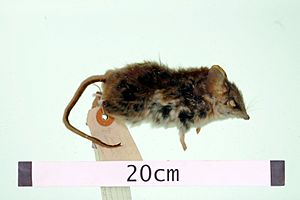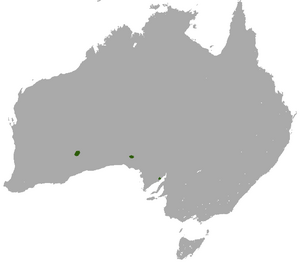Sandhill dunnart facts for kids
Quick facts for kids Sandhill dunnart |
|
|---|---|
 |
|
| Conservation status | |
| Scientific classification | |
| Genus: |
Sminthopsis
|
| Species: |
psammophila
|
 |
|
| Sandhill dunnart range | |
The sandhill dunnart (Sminthopsis psammophila) is a small, meat-eating marsupial from Australia. It belongs to the Dasyuridae family, which includes many small marsupials. This rare animal lives in four separate dry areas of Australia. These places are near Lake Amadeus in the Northern Territory, the central Eyre Peninsula in South Australia, the southwest part of the Great Victoria Desert in Western Australia, and at Yellabinna in South Australia.
Contents
What Does the Sandhill Dunnart Look Like?
Sandhill dunnarts are sometimes called marsupial mice. They are usually 10 to 16 centimeters long, which is about 4 to 6 inches. Most dunnarts have fine gray or black fur. They also have large ears and thick tails with short, stiff hairs. It is known that the dunnart stores all its fat in its tail.
The sandhill dunnart is one of the largest and rarest of all dunnarts. It is colored grey to buff. It is found in low, parallel sand dunes, especially near hummock grass. They usually move by running smoothly on all four legs. Sometimes they stop suddenly and squat down with their front body slightly raised.
The sandhill dunnart is the second largest of the 19 dunnart species. Adult females weigh about 35 grams, and males weigh about 44 grams. Only the Julia Creek dunnart is larger.
What Do Sandhill Dunnarts Eat and How Do They Behave?
The sandhill dunnart is one of the larger dunnart species, weighing from 30 to 55 grams. You might think their size means they eat bigger bugs. However, this medium-sized marsupial prefers smaller prey. They eat things like ants, beetles, spiders, grasshoppers, termites, wasps, and centipedes.
These dunnarts are known to eat many different things. They are very good at finding food whenever they can. They are also fierce hunters. Their diet stays strong in all seasons, changing only a little bit.
When food is hard to find, dunnarts can enter a short, light sleep-like state called torpor. This helps them save water and energy. This special ability helps them survive when conditions are tough.
Reproduction and Life Cycle
Sandhill dunnarts usually start breeding in September. Their babies are born from September to October. Young dunnarts have also been found in October and April. This might mean that if conditions are good, dunnarts can have another group of babies. It takes about 16 to 19 days from mating until the babies are born.
Both male and female dunnarts can start having babies when they are one year old. We don't know how old they get before they can no longer reproduce. However, male dunnarts in zoos have bred when they were five years old. Female dunnarts in zoos have bred when they were three years old.
Where Do Sandhill Dunnarts Live?
The sandhill dunnart lives in sandy, dry, and semi-dry areas of Australia. These areas have Spinifex grass hummocks. Spinifex hummocks are very important for the dunnart because they have specific needs for their home.
Dunnarts dig burrows under larger Spinifex hummocks. These burrows protect them from very hot or humid weather. The burrows can be about 12 to 110 centimeters long and up to 46 centimeters deep. Female dunnarts sometimes dig deeper to create a special room for raising their young. Male dunnarts often use smaller burrows between Spinifex clumps, hollow logs, or even burrows dug by other animals.
As Spinifex hummocks disappear, the dunnart's living area also shrinks. Their home is now mostly limited to the Eyre Peninsula in South Australia, and the Great Victoria Desert in South and Western Australia. They were first seen in the Northern Territory, but they haven't been seen there since the late 1800s.
What Threats Do Sandhill Dunnarts Face?
We don't know the exact reasons why the Sandhill Dunnart population is shrinking. However, they are likely in danger from several things.
- New Animals: Animals like foxes and cats, which were brought to Australia, hunt dunnarts.
- Habitat Damage: Farm animals eating too much grass can damage the dunnart's home.
- Fires: The way fires are managed can also hurt their habitat. Even though dunnarts can move back into areas after fires, one big fire can wipe out a whole group. When their homes become separated, it's harder for them to move to new areas.
- Land Clearing: In the Eyre Peninsula, land has been cleared for farming. This has greatly reduced the dunnart's living space. Only about 43 percent of the original plants are left in that area.
Conservation Status
The sandhill dunnart is listed as "vulnerable" under the Environment Protection and Biodiversity Conservation Act 1999. This means it needs special protection. It is protected in some special areas, like the Ironstone Hill Conservation Park and the Yellabinna Wilderness Protection Area in South Australia. It is also protected in the Queen Victoria Spring Nature Reserve in Western Australia.
In 2001, a plan was made to help the species recover. This plan included several actions:
- Stopping more clearing of their homes.
- Looking for dunnarts in areas where they might live.
- Watching key groups of dunnarts to see how they are doing.
- Studying dunnarts in captivity to learn more about how they have babies.
- Suggesting controlled fires to help grow suitable Spinifex habitat.
See also
 In Spanish: Ratón marsupial del desierto para niños
In Spanish: Ratón marsupial del desierto para niños


